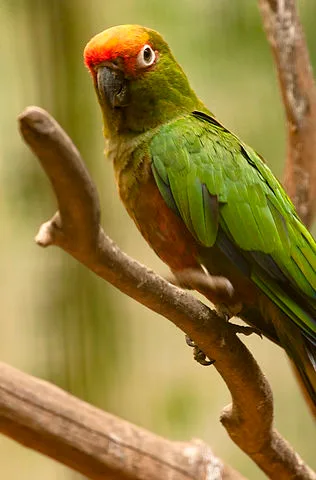Written by PoB, verified by Editorial Team
February 28, 2012

Golden-capped Parakeet
[order] PSITTACIFORMES | [family] Psittacidae | [latin] Aratinga auricapillus | [authority] Kuhl, 1820 | [UK] Golden-capped Parakeet | [FR] Conure a tete d’or | [DE] Goldkopfsittich | [ES] Aratinga testadorada | [NL] Goudkapparkiet | [copyright picture] Peter Tan
| Genus | Species | subspecies | Region | Range |
| Aratinga | auricapillus | | SA | se Brazil |
| Aratinga | auricapillus | auricapillus | | ec Brazil |
| Aratinga | auricapillus | aurifrons | | se Brazil |
Genus
The parrot genus Aratinga comprises 24 species. Aratinga is a genus of American parakeets. They belong to the long-tailed group. Most are predominantly green, although a few are predominantly yellow or orange. They are social and commonly seen in groups in the wild. In Brazil the popular name of several species usually is Jandaia, sometimes written as Jandaya in the scientific form.
The genus Aratinga includes species with habitat from South America to Mexico. Birds in the Aratinga genus have a “swift, direct flight” that differs from other similar birds according to “Parrots of the World.” Other characteristics include the males and females looking alike, a fully feathered face and a rather long tail that starts wide at the base and becomes slender at the tip.
Green parakeet with orange-red belly and facial markings. Red frontlet, lores and area around eyes grading to bright orange in forecrown and bright yellow in mid-crown. Large, dull orange-red belly patch, mottled yellow. Reddish underwing-coverts. Bluish primaries with green patch. Dull bluish tail with green in base and red on central rectrices. Feathers of lower back and rump edged reddish. Blackish bill. Race aurifrons is deeper green with more extensive red on head, reduced patch on belly and no red on mantle.
Listen to the sound of Golden-capped Parakeet
[audio:https://planetofbirds.com/MASTER/PSITTACIFORMES/Psittacidae/sounds/Golden-capped Parakeet.mp3]
Copyright remark: Most sounds derived from xeno-canto
recorded by Vitor Torga Lombardi
| wingspan min.: | 0 | cm | wingspan max.: | 0 | cm |
| size min.: | 30 | cm | size max.: | 32 | cm |
| incubation min.: | 0 | days | incubation max.: | 0 | days |
| fledging min.: | 0 | days | fledging max.: | 0 | days |
| broods: | 1 | | eggs min.: | 3 | |
| | | | eggs max.: | 5 | |
South America : Southeast Brazil. Brazil from the Reconcavo area in Bahia, south to Minas Gerais, Espirito Santo, Rio de Janeiro, Sao Paulo, Goias and Parana, south-east Brazil.
It is found in both humid Atlantic coastal forest and inland transitional forests. It is largely dependent on semi-deciduous forest, but forages and breeds in forest edge, adjacent secondary growth, agricultural areas and even urban areas. Like other Aratinga, it seems to adapt well to mosaics of forest fragments, pastures and agriculture, and in Goias and Minas Gerais it also uses areas of cerrado.
Hardly any information, seems to breed in october, some suggest the summer. Clutch size in captivity 3-5 eggs.
It feeds on fruits (such as mango, papaya and orange) and seeds (such as maize), and was formerly considered a serious pest.
Video Golden-capped Parakeet
httpv://www.youtube.com/watch?v=v-yESteesNY
copyright: Josep del Hoyo
This species is thought to have a moderately small population which is declining in some areas owing to habitat loss. However it seems to cope relatively well with alteration of its habitat and is consequently classified as Near Threatened.
There has been extensive and continuing clearance and fragmentation of suitable habitat for coffee, soybean and sugarcane plantations in S

